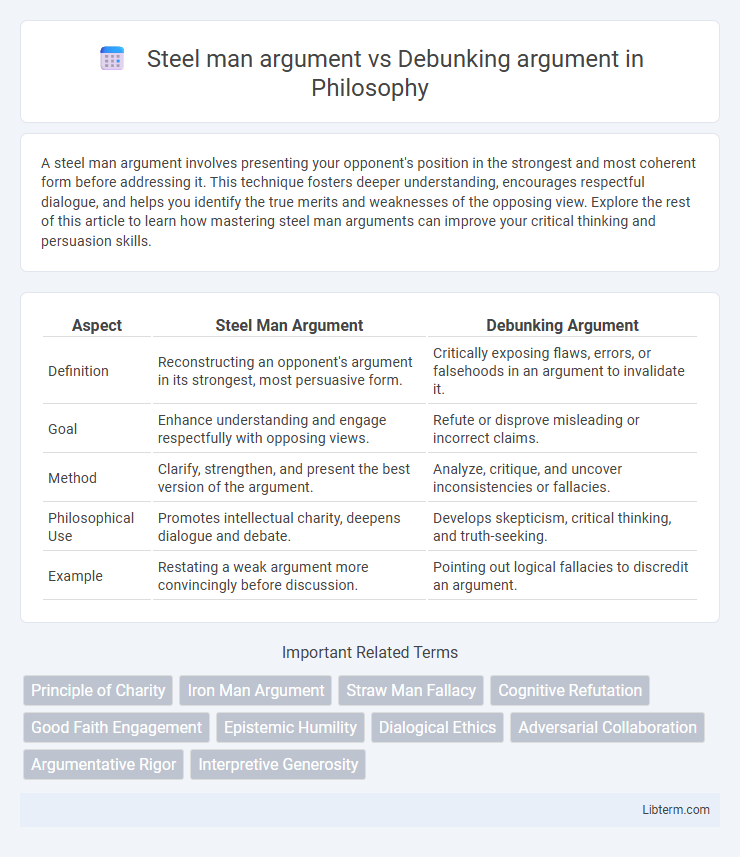A steel man argument involves presenting your opponent's position in the strongest and most coherent form before addressing it. This technique fosters deeper understanding, encourages respectful dialogue, and helps you identify the true merits and weaknesses of the opposing view. Explore the rest of this article to learn how mastering steel man arguments can improve your critical thinking and persuasion skills.
Table of Comparison
| Aspect | Steel Man Argument | Debunking Argument |
|---|---|---|
| Definition | Reconstructing an opponent's argument in its strongest, most persuasive form. | Critically exposing flaws, errors, or falsehoods in an argument to invalidate it. |
| Goal | Enhance understanding and engage respectfully with opposing views. | Refute or disprove misleading or incorrect claims. |
| Method | Clarify, strengthen, and present the best version of the argument. | Analyze, critique, and uncover inconsistencies or fallacies. |
| Philosophical Use | Promotes intellectual charity, deepens dialogue and debate. | Develops skepticism, critical thinking, and truth-seeking. |
| Example | Restating a weak argument more convincingly before discussion. | Pointing out logical fallacies to discredit an argument. |
Understanding the Steel Man Argument
The Steel Man Argument involves accurately and charitably reconstructing an opponent's position to its strongest and most persuasive form, enhancing clarity and fostering constructive dialogue. This approach improves critical thinking by promoting empathy and a deeper understanding of differing perspectives, reducing misrepresentation and straw man fallacies. Mastering the Steel Man technique leads to more productive debates and the potential for finding common ground or better solutions.
What is a Debunking Argument?
A debunking argument aims to expose falsehoods or misconceptions by providing evidence that disproves a claim or belief, often highlighting logical fallacies or factual inaccuracies. It scrutinizes the validity of an argument by examining inconsistencies and presenting counter-evidence to undermine the original position. Unlike steel man arguments, which reconstruct the strongest version of an opposing view, debunking arguments focus primarily on refuting and invalidating misinformation.
Origins and Philosophy Behind Each Approach
Steel man argument originates from charitable interpretation in philosophy, emphasizing reconstructing an opponent's reasoning in its strongest, most persuasive form to promote genuine understanding and constructive dialogue. Debunking argument stems from skepticism and critical inquiry traditions, aiming to expose flaws, misconceptions, or falsehoods by rigorously challenging and dismantling claims. The philosophy behind steel manning fosters empathy and approximation of truth through refinement, while debunking seeks epistemic vigilance and correction by revealing errors.
Core Principles: Clarity vs Critique
The steel man argument emphasizes clarity by reconstructing an opponent's position in its strongest and most coherent form, ensuring accurate representation and fostering genuine understanding. In contrast, the debunking argument prioritizes critique by identifying and exposing flaws, inconsistencies, or falsehoods within a claim to undermine its credibility. These core principles highlight the steel man's commitment to intellectual charity, while debunking focuses on rigorous evaluation and factual refutation.
Techniques for Steel Manning an Opponent’s View
Steel man arguments involve reconstructing an opponent's position in its strongest, most persuasive form to ensure fair and rigorous debate, while debunking arguments focus on identifying errors or flaws in the opponent's claims. Key techniques for steel manning include accurately restating the argument without distortion, addressing the strongest evidence or rationale the opponent provides, and acknowledging valid points before presenting counterarguments. This approach fosters intellectual honesty, promotes constructive dialogue, and encourages deeper understanding of the issues at hand.
Steps in Constructing Effective Debunking Arguments
Effective debunking arguments require identifying the false claim, understanding its appeal, and clearly presenting factual evidence that contradicts it, while avoiding repetition of the myth to prevent reinforcement. The process involves acknowledging the audience's perspective, using simple and clear language, and providing a plausible alternative explanation to fill the gap left by the debunked misinformation. Empirical studies suggest that combining factual refutations with coherent narratives increases the likelihood of reducing belief in false information.
Strengths and Weaknesses: Steel Man vs Debunking
Steel man arguments strengthen discourse by presenting the opposing view in its strongest, most persuasive form, which fosters better understanding and reduces misinterpretations, but may require significant effort and deep empathy that can slow debate. Debunking arguments focus on exposing flaws or falsehoods quickly and effectively, helping to correct misinformation and promote critical thinking, though they risk oversimplification or dismissiveness that can alienate opponents or cause defensive reactions. Balancing the steel man's thoroughness with the debunker's clarity optimizes persuasive communication and intellectual rigor.
Impact on Productive Dialogue and Discourse
Steel man argument enhances productive dialogue by reconstructing the strongest version of an opponent's position, promoting mutual understanding and intellectual humility. Debunking argument often focuses on dismantling flawed claims, which can shut down conversation or foster defensiveness if not approached constructively. Employing steelmanning techniques leads to more respectful, insightful discourse, encouraging problem-solving and collaboration.
Common Pitfalls and Misconceptions
Steel man arguments often avoid common pitfalls like straw man fallacies by reconstructing the strongest version of an opponent's position, ensuring a fair and honest engagement. A common misconception is that debunking arguments always require direct refutation; however, effective debunking demands addressing underlying assumptions and evidence without oversimplification. Both approaches risk miscommunication if they fail to recognize the complexity of opposing views or rely on superficial criticisms.
Choosing the Right Approach for Better Arguments
Choosing the right approach between steel man arguments and debunking arguments depends on the goal of the discussion; steel man arguments strengthen understanding by fairly representing opposing views, fostering empathy and clarity. Debunking arguments focus on critically examining and exposing flaws, which is effective for pinpointing errors and misinformation. Employing steel man tactics enhances constructive dialogue, while debunking is essential for rigorous critique and fact-checking in debate settings.
Steel man argument Infographic

 libterm.com
libterm.com